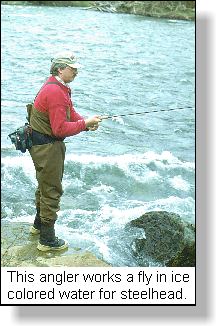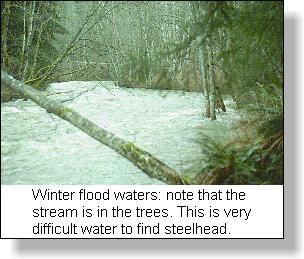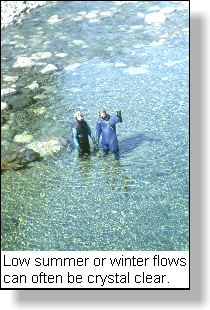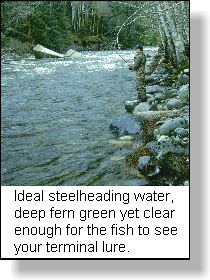
Steelhead Fishing Series
"Steelhead Fishing a New River"
Part 1: Water Color
with Barry M. Thornton
 Whenever I fish a new river for steelhead I consider a number of factors
before even casting. Color of water; range between pools and riffles; streamside
canopy; size of river; dominant riverbed material; historic fishery; and
access routes; these are all elements in a day's success and pleasure on
our B.C. steelhead rivers. Over the years I have found that while fish holding
locations are the one constant while steelheading, it is these other factors
that dictate my success and pleasure on a new river.
In this two part article I will first look at water color, what I consider
is the most important factor, and it's effect on winter steelhead fishing.
In my next article I will look at some of the other factors I have listed
above and how they too impact the winter steelheader.
The color of river water creates a number of interesting challenges for
the steelheader. It affects fish location and angler casting locations and
wading. But, above all else, the water color, that day, determines lure
selection and principle presentation used.
 The ideal winter steelhead water is a deep fern
green. It is the dominant color of most coastal rivers due to the higher
winter flows caused by tributary run-off mix, headwater snow melt, and seasonal
rains. The depth of green varies with each watershed but it provides clarity
in pool tailouts and overhead protection in pool depths - all factors which
winter steelhead prefer. Most B.C. steelhead rivers have this color for
most of the winter season. For the fly fisher this is 'any' attractor fly
water. Use a pattern with which you have confidence and fish it as you would
on The ideal winter steelhead water is a deep fern
green. It is the dominant color of most coastal rivers due to the higher
winter flows caused by tributary run-off mix, headwater snow melt, and seasonal
rains. The depth of green varies with each watershed but it provides clarity
in pool tailouts and overhead protection in pool depths - all factors which
winter steelhead prefer. Most B.C. steelhead rivers have this color for
most of the winter season. For the fly fisher this is 'any' attractor fly
water. Use a pattern with which you have confidence and fish it as you would
on
your home river. For the lure fisher, this is the color that demands the
use of any bright lure whether it be a stream spinner or a bottom bouncing
drifter. In this deep green water steelhead are capable of seeing most offerings
well before they reach the area where the fish rests.
Winter steelhead are not active
fish. It is rare that they will actively move from their resting position
to take a steelheader's offering. Most steelhead will never take any offering
regardless of presentation. Steelheaders need to recognize this fact and
hunt for those 'catchables' that will strike. Presentations must be near
and even bouncing along the bottom of the stream. In most cases the 'catchables'
will take the offering with the least expenditure of energy; that is, they
will simply open their mouth and take the offering as it passes in front
of them. Fish the bottom - ALWAYS! That is a truism of steelhead angling.
 Some rivers have a rich tea color as a result
of tannin leaching from evergreens in their watersheds. In these waters
the fly fisher needs to use large bright attractor flies because the tannin
dulls color. The lure fisher also requires bright lures which will attract
the steelhead's attention. In tannin waters I often fish with magnum sized
rubber latex lures like the Gooey-bob, or large fluorescent orange Spin-&-Glows
because they show up so well. In these tannin waters the fly fisher should
use large flies, those with dominant silver and fluorescent patterns. Some rivers have a rich tea color as a result
of tannin leaching from evergreens in their watersheds. In these waters
the fly fisher needs to use large bright attractor flies because the tannin
dulls color. The lure fisher also requires bright lures which will attract
the steelhead's attention. In tannin waters I often fish with magnum sized
rubber latex lures like the Gooey-bob, or large fluorescent orange Spin-&-Glows
because they show up so well. In these tannin waters the fly fisher should
use large flies, those with dominant silver and fluorescent patterns.
Some rivers have heavy clay deposits in their watersheds. In heavy runoff
times these waters become colloidal, suspending the clay sediment in the
water like cream in coffee. Because winter steelhead rest where there is
light, in these cream colored streams they can be found right at the beach,
in calf deep water where you would normally wade. Use bright lures and fly
patterns and make a habit to drift and swing them through the shallow reaches
particularly where there are overhanging boughs which give the fish added
security.
Clear water is a most common occurrence in coastal rivers during the winter
due to cold 'snaps' in mountain watersheds. Clear means clear! Those anglers
who swim rivers with face masks know that when the river is clear, underwater
pebbles can be counted on the far beach, as can the scales on individual
steelhead, or, the toe of a wader carelessly put in the water. Small dark
flies or small imitation eggs are the most effective producers in this circumstance;
fished on the bottom.
Depending upon the weather when you are fishing, river levels can be high
or low, muddy colored, clear, or in between; usually in between has been
my experience when I am searching out new waters. Go prepared with a kit
capable of fishing all conditions even if it does weigh the proverbial 'ton'.
 Choose your tackle based upon water conditions
as I have suggested above. But, be prepared for the unusual. Should the
waters be warming, which may occur from a sudden rainstorm, some winter
fish will behave like summer steelhead and take your lure near the surface.
If there is a run of kelts moving downstream they also may take a moving
or near surface lure. Should the water be high but clearing, there will
likely be a fresh run of fish entering the river; then concentrate on the
lower reaches near the estuary. Should there be bark, twigs, and other debris
floating downstream you know the river is rising and the fish will move
to the tailout of Choose your tackle based upon water conditions
as I have suggested above. But, be prepared for the unusual. Should the
waters be warming, which may occur from a sudden rainstorm, some winter
fish will behave like summer steelhead and take your lure near the surface.
If there is a run of kelts moving downstream they also may take a moving
or near surface lure. Should the water be high but clearing, there will
likely be a fresh run of fish entering the river; then concentrate on the
lower reaches near the estuary. Should there be bark, twigs, and other debris
floating downstream you know the river is rising and the fish will move
to the tailout of
pools. But, should the waters be low and clear cast to the whitewater sections
behind instream boulders or at the head of a pool where steelhead will seek
for it's added security.
Water color is unique to every river system. Each river's unique race of
winter steelhead has evolved to capitalize on the color of that watershed
to give them the greatest sense of safety and the greatest opportunity to
reach the spawning beds. The steelheader can greatly increase his pleasure
and success in new waters if he studies that water carefully before selecting
his tackle and casting.
Part 2: Other factors to consider when steelheading
a new river.
© Copyright Barry M. Thornton
Barry M. Thornton
|





 The ideal winter steelhead water is a deep fern
green. It is the dominant color of most coastal rivers due to the higher
winter flows caused by tributary run-off mix, headwater snow melt, and seasonal
rains. The depth of green varies with each watershed but it provides clarity
in pool tailouts and overhead protection in pool depths - all factors which
winter steelhead prefer. Most B.C. steelhead rivers have this color for
most of the winter season. For the fly fisher this is 'any' attractor fly
water. Use a pattern with which you have confidence and fish it as you would
on
The ideal winter steelhead water is a deep fern
green. It is the dominant color of most coastal rivers due to the higher
winter flows caused by tributary run-off mix, headwater snow melt, and seasonal
rains. The depth of green varies with each watershed but it provides clarity
in pool tailouts and overhead protection in pool depths - all factors which
winter steelhead prefer. Most B.C. steelhead rivers have this color for
most of the winter season. For the fly fisher this is 'any' attractor fly
water. Use a pattern with which you have confidence and fish it as you would
on Some rivers have a rich tea color as a result
of tannin leaching from evergreens in their watersheds. In these waters
the fly fisher needs to use large bright attractor flies because the tannin
dulls color. The lure fisher also requires bright lures which will attract
the steelhead's attention. In tannin waters I often fish with magnum sized
rubber latex lures like the Gooey-bob, or large fluorescent orange Spin-&-Glows
because they show up so well. In these tannin waters the fly fisher should
use large flies, those with dominant silver and fluorescent patterns.
Some rivers have a rich tea color as a result
of tannin leaching from evergreens in their watersheds. In these waters
the fly fisher needs to use large bright attractor flies because the tannin
dulls color. The lure fisher also requires bright lures which will attract
the steelhead's attention. In tannin waters I often fish with magnum sized
rubber latex lures like the Gooey-bob, or large fluorescent orange Spin-&-Glows
because they show up so well. In these tannin waters the fly fisher should
use large flies, those with dominant silver and fluorescent patterns. Choose your tackle based upon water conditions
as I have suggested above. But, be prepared for the unusual. Should the
waters be warming, which may occur from a sudden rainstorm, some winter
fish will behave like summer steelhead and take your lure near the surface.
If there is a run of kelts moving downstream they also may take a moving
or near surface lure. Should the water be high but clearing, there will
likely be a fresh run of fish entering the river; then concentrate on the
lower reaches near the estuary. Should there be bark, twigs, and other debris
floating downstream you know the river is rising and the fish will move
to the tailout of
Choose your tackle based upon water conditions
as I have suggested above. But, be prepared for the unusual. Should the
waters be warming, which may occur from a sudden rainstorm, some winter
fish will behave like summer steelhead and take your lure near the surface.
If there is a run of kelts moving downstream they also may take a moving
or near surface lure. Should the water be high but clearing, there will
likely be a fresh run of fish entering the river; then concentrate on the
lower reaches near the estuary. Should there be bark, twigs, and other debris
floating downstream you know the river is rising and the fish will move
to the tailout of